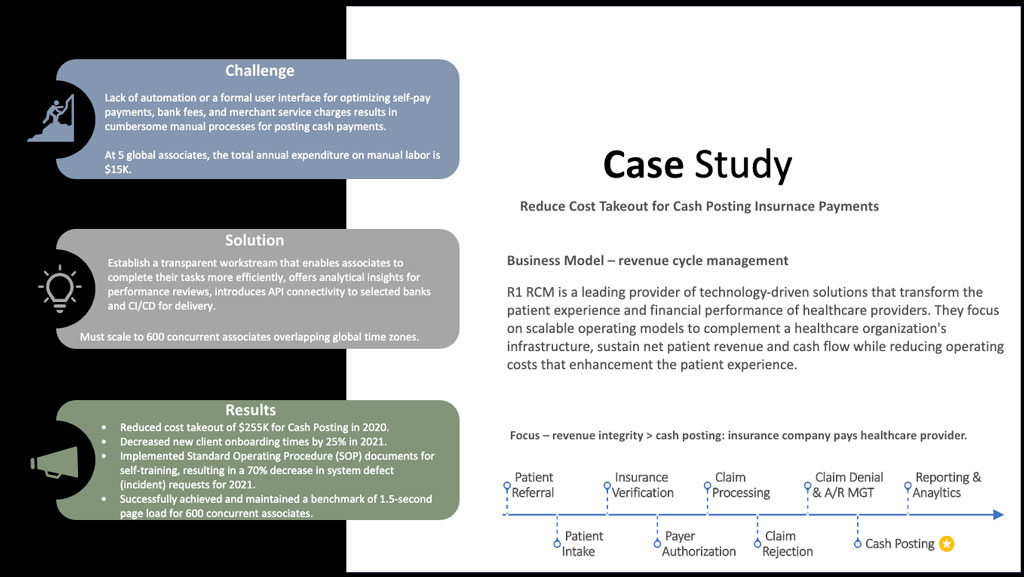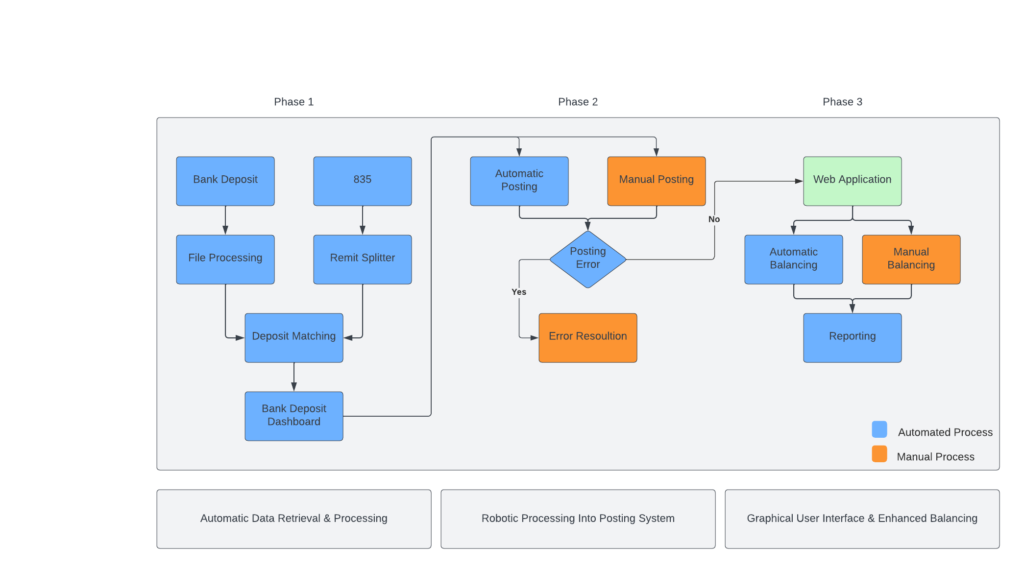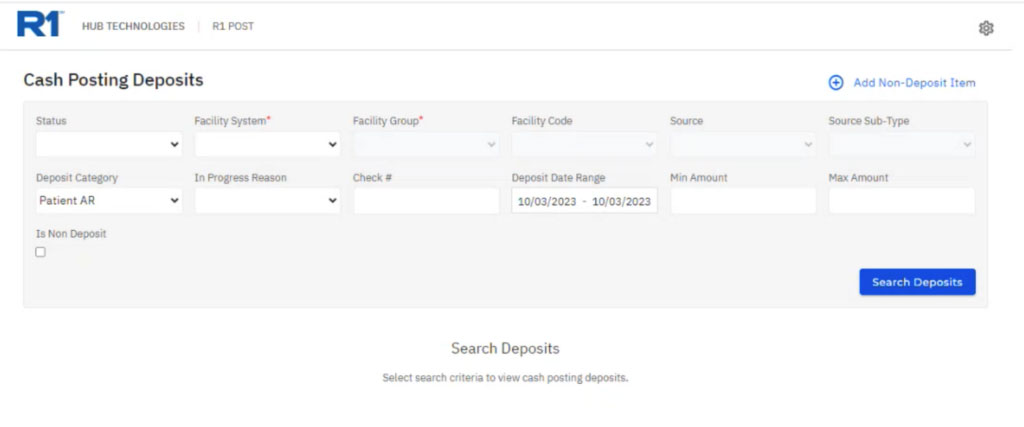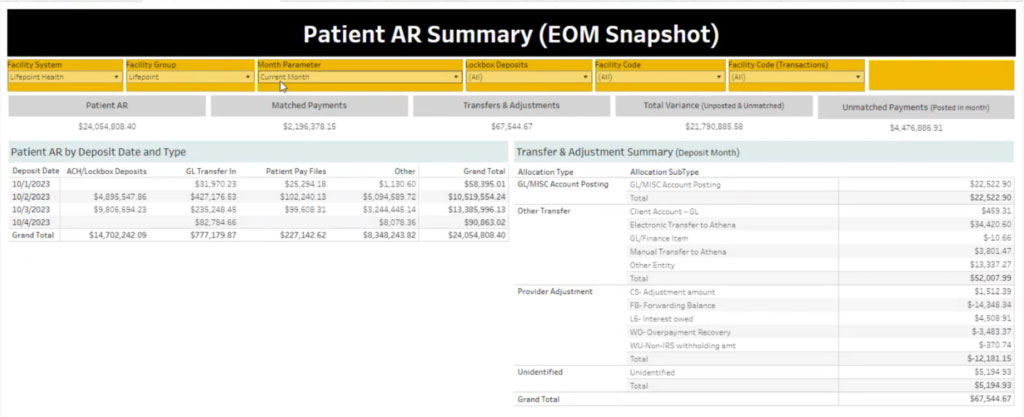Reduce Recurring Cost Takeout by $255K for R1 RCM

Overview
In 2020, as the Senior Technical Product Owner for the Revenue Integrity Platform. I played a pivotal role in shaping both the product strategy and delivery for feature enhancements and architecture enablers. My primary focus within revenue cycle management was focused on Cash Posting, a critical process occurring post-patient procedure and billing.
Details
Here’s are in-depth review of the Product Strategy and Delivery I employed to achieve a $255K reduction in recurring Cost Takeout for R1 RCM.
Product Strategy
- Goals & Mission (OKRs)
- Reduce operational cost by X% with a new workflow
- Improve quality of cash postings submitted by Y with clear business rules
- Accelerate cash posting by $Z when X & Y are working as expected.
- Increase automation of: data retrieval, posting and reconciliation.
- Improve visibility: posting states, associate performance and system health.
- Unmeet Customer Needs (gap analysis)
- No existing cash posting UI to streamline use case outlined by Managers.
- No existing API to define business logic.
- Relational database
- Latency in cash posting is due to minimal system autonomy results in management and associate churn from a reporting and cash posting perspective.
- Cumbersome path between 3 systems to complete a single cash posting scenario.
- Ability to see all of the relevant PHI data for a provider, payer and bank.
- Customer Segmentation (identify commonality)
- US-Onsite, US-remote associates that have an existing PHI / HIPPA work station.
- Associates working on cash posting – self-pay, technical charges (excludes reconciliation for MVP).
- Experience with mid-sized healthcare providers – St. Johns, Kalamazoo and Intermountain Healthcare.
- Integrated Ecosystem (technology & business)
- Architecture documentation will need to be completed (and reviewed with security team) to request hardware / software environments higher than DEV.
- Dependency on design-library to enable a flexible web application UI driven by a micro-frontend. (UI)
- Consider the physical or logical separation of client data and accessibility for the data model. (API)
- Mucky data model will need to be refactored to ensure properly scalability for both the business and technology. (Data Model).
- New deployment > release mechanism should be planned to meet the NFRs for CI/CD and OKR timelines.
Execution & Metrics
- Mission & Why
- Purpose & Vision: scale the cash posting business by decreasing errors and churn.
- Alignment w/ Company Goals: increase monthly cash posting by X and maintain an accuracy of Y to keep operation costs below Z risk management levels.
- Guiding Decisions & Priorities: focussed on a Northstar (use case) discovered through R&D that will be a complete E2E path from start > finish for a single (not bulk) cash posting. E2E needs to consider a vertical slice (UI, API, DM) of value, while following the horizontal slice of provided platform architecture.
- Communication & Stakeholder Alignment: following Agile > Scrum there will be a daily standup for the Scrum Team, PM and chosen key stakeholder. Bi-weekly sprint reviews will have a system demo where a larger group of stakeholders may attend. Release notes will be published bi-weekly and feature details added to Pendo for in-app guides.
- Customer-Centric Focus: always consider giving updates to key stakeholders, management and C-Suite in clear concise (user outcomes) speak. Keep the architecture runways updates for the architecture council, unless requests.
- Long-Term Perspective: this solution is planned to be built with a front-end microservices mindset, thin API’s for scaling / performance and a data model that allows for moving client data from servers to cloud.
- Customer Segmentation
- Outlined above > product strategy > customer segmentation and use cases
- Prioritization
- Aligned with the product strategy, timeline and customer segmentation will drive weekly backlog refinement.
- Bi-weekly established with key stakeholder to ensure prioritization is correct.
- Product Health
- User Satisfaction, Functionality, Performance, Reliability, Security, Maintainability, Market Fit, Financial Performance
- De-risk
- Clear and consistent communication – context over control with the scrum team, concise key stakeholder meetings – prioritization, say-do-ratio, change management – deploy & release process.
- Agile best practices are used to ensure alignment on value being delivered.
- Cannibalization
- Teams will be running the legacy and new workflow in parallel, ensure onboarding and adoption is met before sunsetting.
- Counter Metrics
- Decrease in cash posting accuracy (excludes reconciliation)
- Increase in help-desk tickets to a complicated UI
- Adoption rates are extremely low, until forced to use new delivery path
- Timeline
- June 2019 – December 2020
- Reduced delivery timeline by $1.5MM
Impact to Internal Customer – phase 3 (web application, automatic balancing, reporting) was built for this Case Study.

Web Application UI – built in Node.JS via a design library, API and Database Model – C# 4.6

Reporting (lower environment screenshot w/ test data) – Tableau
